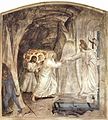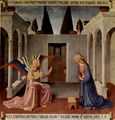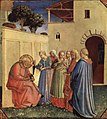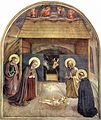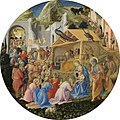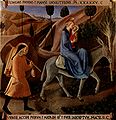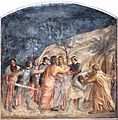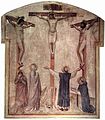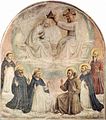Fra Angelico
The Blessed Fra Angelico, (c. 1395 - February 18 1455) was an Early Italian Renaissance painter, referred to in Vasari's Lives of the Artists as having "a rare and perfect talent".[1]
Known in Italy as il Beato Angelico and in the English-speaking world as Fra Angelico, he was known to his contemporaries as Fra Giovanni da Fiesole (Brother John from Fiesole). In Giorgio Vasari’s Lives of the Artists, written prior to 1555, he is already known as Fra Giovanni Angelico (Brother Giovanni the Angelic One).[2]
Within his lifetime or shortly thereafter he was also called "Il Beato" (the Blessed), in reference to his skills in painting religious subjects.[3] In 1982 Pope John Paul II conferred beatification, thereby making this title official. Fiesole is sometimes misinterpreted as being part of his formal name, but it was merely the name of the town where he took his vows, used by contemporaries to separate him from other Fra Giovannis. He is listed in the Roman Martyrology[4] as "Beatus Ioannes Faesulanus, cognomento Angelicus" - "Blessed Giovanni of Fiesole, nicknamed Angelico".
The 16th century biographer Vasari says of him:
"But it is impossible to bestow too much praise on this holy father, who was so humble and modest in all that he did and said and whose pictures were painted with such facility and piety."[5]

Biography
Early life, 1395-1436

Fra Angelico was born Guido di Pietro, at Rupecanina[1], in the Tuscan area of Mugello, near Fiesole towards the end of the 14th century and died in Rome in 1455. Nothing is known of his parents. He was baptized Guido or Guidolino. The earliest recorded document concerning Fra Angelico dates from Oct. 17, 1417 when he joined a religious confraternity at the Carmine, still under the name of Guido di Pietro. This record also reveals that he was already a painter, a fact that is subsequently confirmed by two records of payment to Guido di Pietro in January and February of 1418 for work done in the church of Santo Stefano del Ponte.[6] The first record of Angelico as a friar dates from 1423, when he is first referred to as Fra Giovanni, following the custom of those in Holy Orders of taking a new name.[7] He was a member of the Observant Branch of the Dominican Order at Fiesole.
Fra Angelico initially received training as an illuminator, possibly working with his older brother Benedetto who was also a Dominican. His illumination tutor is unknown. San Marco in Florence holds several manuscripts that are thought to be entirely or partly by his hand. The painter Lorenzo Monaco may have contributed to his art training, and the influence of the Sienese school is discernible in his work. He had several important charges in the convents he lived in, but this did not limit his art, which very soon became famous. According to Vasari, the first paintings of this artist were an altarpiece and a painted screen for the Carthusian Monastery of Florence; none such exist there now.
From 1408 to 1418 Fra Angelico was at the Dominican Convent of Cortona where he painted frescoes, now destroyed, in the Dominican Church and may have been assistant to or follower of Gherardo Starnina[2]. Between 1418 and 1436 he was at the convent of Fiesole where he also executed a number of frescoes for the church, and the Altarpiece, deteriorated but restored. A predella of the Altarpiece remains intact in the National Gallery, London which is a superb example of Fra Angelico's ability. It shows Christ in Glory, surrounded by more than 250 figures, including beatified Dominicans.
The Vatican, 1445-1455

In 1445 Pope Eugenius IV summoned him to Rome to paint the frescoes of the Chapel of the Holy Sacrament at St Peter's, later demolished by Pope Paul III. Vasari claims that at this time Fra Angelico was offered by Pope Nicholas V the Archbishopric of Florence, and that he refused it, recommending another Friar for the position. While the story seems possible and even likely, if Vasari's date is correct, then the pope must have been Eugenius and not Nicholas. In 1447 Fra Angelico was in Orvieto with his pupil, Benozzo Gozzoli, executing works for the Cathedral. Among his other pupils were Gentile da Fabriano and Zanobi Strozzi[3].
From 1447 to 1449 he was back at the Vatican designing the frescoes for the Niccoline Chapel for Nicholas V. The scenes from the lives of the two martyred Deacons of the Early Christian Church, St. Stephen and St. Lawrence may have been exectuted wholly or in part by assistants. The small chapel, with its brightly frescoed walls and gold leaf decorations gives the impression of a jewel box. From 1449 until 1452, Fra Angelico was back at his old convent of Fiesole, where he was the Prior. In 1455 he was staying at a Dominican Convent in Rome, perhaps in order to work on Pope Nicholas' Chapel. It was there that he died, his body being buried in the church of Santa Maria sopra Minerva.

Fra Angelico was beatified by Pope John Paul II in 1982. The Pope said:
"Angelico was reported to say "He who does Christ's work must stay with Christ always". This motto earned him the epithet "Blessed Angelico", because of the perfect integrity of his life and the almost divine beauty of the images he painted, to a superlative extent those of the Blessed Virgin Mary."
W.M.Rossetti writes:
"From various accounts of Fra Angelico's life, it is possible to gain some sense of why he was deserving of canonization. He led the devout and ascetic life of a Dominican friar, and never rose above that rank; he followed the dictates of the order in caring for the poor; he was always good-humored. All of his many paintings were of divine subjects, and it seems that he never altered or retouched them, perhaps from a religious conviction that, because his paintings were divinely inspired, they should retain their original form. He was wont to say that he who illustrates the acts of Christ should be with Christ. It is averred that he never handled a brush without fervent prayer and he wept when he painted a Crucifixion. The Last Judgment and the Annunciation were two of the subjects he most frequently treated."[8]
Epitaph
The words engraved on Fra Angelico's tomb translate as
When singing my praise, don't liken my talents to those of Apelles.
Say, rather, that, in the name of Christ, I gave all I had to the poor.
The deeds that count on Earth are not the ones that count in Heaven.
I, Giovanni, am the flower of Tuscany.[9]
Evaluation
Fra Angelico was working at a time when the style of painting was in a state of change. This process of change had begun a hundred years previous with the works of Giotto and several of his contemporaries, notably Giusto de' Menabuoi, both of whom had created their major works in Padua, although Giotto was trained in Florence by the great Gothic artist, Cimabue, and painted a fresco cycle of St Francis in the Bardi Chapel in Santa Croce. Giotto had many enthusiastic followers, who imitated his style in fresco, some of them, notably the Lorenzetti, achieving great success.
Patronage
The patrons of these artists were most often monastic establishments or wealthy families endowing a church. Because the paintings often had devotional purpose, the clients tended to be conservative. Frequently, it would seem, the wealthier the client, the more conservative the painting. There was a very good reason for this. The paintings that were commissioned made a statement about the patron. Thus the more gold leaf it displayed, the more it spoke to the patron’s glory. The other valuable commodities in the paint-box were lapis lazuli and vermilion. Paint made from these colours did not lend itself to a tonal treatment. The azure blue made of powdered lapis lazuli went on flat, the depth and brilliance of colour being, like the gold leaf, a sign of the patron’s ability to provide well. For these reasons, altarpieces are often much more conservatively painted than frescoes, which were often of almost life-sized figures and relied upon a stage-set quality rather than lavish display in order to achieve effect.
Contemporaries
Fra Angelico was the contemporary of Gentile da Fabriano. Gentile’s altarpiece of the Adoration of the Magi, 1423, in the Uffizi is regarded as one of the greatest works of the style known as International Gothic. At the time it was painted, another young artist, known as Masaccio, was working on the frescoes for the Brancacci Chapel at the church of the Carmine. Masaccio had fully grasped the implications of the art of Giotto. Few painters in Florence saw his sturdy, life-like and emotional figures and were not affected by them. His work partner was an older painter,Masolino, of the same generation as Fra Angelico. Sadly Masaccio died at 27, leaving the work unfinished.
Altarpieces

The works of Fra Angelico reveal elements that are both conservatively Gothic and progressively Renaissance. In the altarpiece of the Coronation of the Virgin, painted for the Florentine church of Santa Maria Novella, we see all the elements that a very expensive altarpiece of the 14th century was expected to provide- a precisely tooled gold background, lots of azure, lots of vermilion and an obvious display of arsenic green. The
Frescoes

The series of frescoes that Fra Angelico painted for the Dominican Brothers at San’ Marcos realise the advancements made by Masaccio and carry them further. Away from the constraints of wealthy clients and the limitations of panel painting, Fra Angelico was able to express his deep reverence for his God and his knowledge and love of humanity. The meditational frescoes in the cells of the convent have a quieting quality about them. They are humble works in simple colours. There is more mauvish-pink than there is red while the brilliant and expensive blue is almost totally lacking. In its place is dull green and the black and white of Dominican robes. There is nothing lavish, nothing to distract from the spiritual experiences of the humble people who are depicted within the frescoes. Each one has the effect of bringing an incident of the life of Christ into the presence of the viewer. They are like windows into a parallel world. These frescoes remain a powerful witness to the piety of the man who created them.
If it was indeed Cosimo de' Medici who inspired Fra Angelico to create these remarkable works, then he certainly did not let his wealthy patronage influence the good Friar’s mode of artistic expression.
Masaccio had ventured into the field of perspective with his creation of a realistically painted niche at Santa Maria Novella. Fra Angelico demonstrates his understanding of linear perspective particularly in his Annunciation paintings set inside the sort of arcades that Michelozzo and Brunelleschi created at San’ Marco’s and the square in front of it.
Lives of the Saints

When Fra Angelico and his assistants went to the Vatican to decorate the chapel of Pope Nicholas, then the artist was again confronted with the need to please the very wealthiest of clients. In consequence, walking into the small chapel is like stepping into a jewel box. The walls are decked with the brilliance of colour and gold that one sees in the most lavish creations of the Gothic painter Simone Martini at the Lower Church of St Francis of Assisi, a hundred years earlier. Yet Fra Angelico has succeeded in creating designs which continue to reveal his own preoccupation with humanity, with humility and with piety. The figures, in their lavish gilded robes, have the sweetness and gentleness for which his works are famous. According to Vasari "In their bearing and expression, the saints painted by Fra Angelico come nearer to the truth than the figures done by any other artist."[10]
It is probable that much of the actual painting was done by his assistants to his design. Both Benozzo Gozzoli and Gentile da Fabriano were highly accomplished painters. Benozzo took his art further towards the fully developed Renaissance style with his expressive and life-like portraits in his masterpiece of the Journey of the Magi, painted in the Medici’s private chapel at their palazzo.
Artistic legacy
Through Fra Angelico's pupil Benozzo Gozzoli’s careful portraiture and technical expertise in the art of fresco we see a link to Ghirlandaio, who in turn painted extensive schemes for the wealthy patrons of Florence, and through Ghirlandaio to his pupil Michelangelo and the High Renaissance.
Apart from the lineal connection, superficially there may seem little to link the humble priest with his sweetly pretty Madonnas and timeless Crucifixions to the dynamic expressions of Michelangelo’s larger-than-life creations. But both these artists received their most important commissions from the wealthiest and most powerful of all patrons, the Vatican.
When Michelangelo took up the Sistine Chapel commission, he was working within a space that had already been extensively decorated by other artists. Around the walls the Life of Christ and Life of Moses were depicted by a range of artists including his teacher Ghirlandaio, Raphael’s teacher Perugino and Botticelli. They were works of large scale and exactly the sort of lavish treatment to be expected in a Vatican commission, vying with each other in complexity of design, number of figures, elaboration of detail and skilful use of gold leaf. Above these works stood a row of painted Popes in brilliant brocades and gold tiaras. None of these splendours have any place in the work which Michelangelo created.
Within the cells of San’Marco, Fra Angelico had demonstrated that painterly skill and the artist’s personal interpretation of his subject can create a truly great work of religious art, (or for that matter, any art). In the use of the unadorned fresco technique, the clear bright pastel colours, the careful arrangement of a few significant figures and the skilful use of expression, motion and gesture, Michelangelo shows himself to be the artistic descendant of Fra Angelico.
Fra Angelico and the succession to Michelangelo
-
Fra Angelico, fresco from the cells of San' Marco. Christ reaches out to Adam to rescue him from Hell. c.1440
-
Benozzo Gozzoli, Journey of the Magi, fresco, depicting members of the Medici family and a visiting dignitory as the wise men c.1460
-
Ghirlandaio, fresco, a typical patron-pleasing work showing the young women of Florence in elaborate brocades, in attendance at the Birth of Mary. c.1490
-
Michelangelo, God creating Adam, fresco, showing the iconic representation of God's connection with humankind through Adam. c.1510
Works




Early works, 1408-1436
- Altarpiece - Coronation of the Virgin, with predellas of Miracles of St Dominic; Louvre.
- Altarpiece - Virgin and Child between Saints Peter, Thomas Aquinas, Dominic and Peter Martyr; see detail, right.
- Predella - Christ in Majesty, National Gallery, London.
Florence, Santa Trinita
- Deposition of Christ, said by Vasari to have been “painted by a saint or an angel”. Now in the National Museum of San Marco, Florence.
Florence, Santa Maria degli Angeli
- Last Judgement, Accademia.
Florence, Santa Maria Novella
- Altarpiece - Coronation of the Virgin, Uffizi.
San Marco, Florence, 1436-1445
- Altarpiece for chancel - Virgin with Saints Cosmas and Damian, attended by Saints Dominic, Peter, Francis, Mark, John Evangelist and Stephen. Cosmas and Damian were patrons of the Medici; the altarpiece was commissioned in 1438 by Cosimo de' Medici. It was removed and disassembled during the renovation of the convent church in the seventeenth century. Two of the nine predella panels remain at the convent; seven are in Washington, Munich, Dublin and Paris. Unexpectedly, in 2006 the last two missing panels, Dominican saints from the side panels, turned up in the estate of a modest collector in Oxfordshire, who had bought them in California in the 1960s. (San Marco Altarpiece)
- Altarpiece ? – Madonna and Child with twelve Angels (life sized) ; Uffizi.
- Altarpiece - The Annunciation
- Two versions of the Crucifixion with St Dominic; in the Cloister
- Very large Crucifixion with Virgin and 20 saints; in the Chapter House
- The Annunciation; at the top of the Dormitory stairs. This is probably the most reproduced of all Fra Angelico's paintings.
- Virgin enthroned with Four Saints; in the Dormitory passage
Each cell is decorated with a fresco which matches in size and shape the single round-headed window beside it. The frescoes are apparently for contemplative purpose. They are have a pale, serene, unearthly beauty. Many of Fra Angelico’s finest and most reproduced works are among them. There are, particularly in the inner row of cells, some of less inspiring quality and of more repetitive subject, perhaps completed by assistants.
- The Adoration of the Magi
- The Transfiguration
- Noli me Tangere
- The three Marys at the tomb.
- The Road to Emmaus, with two Dominicans as the disciples
- There are many versions of the Crucifixion
Late works, 1445-1455
Three segments of the ceiling in the Cappella Nuova, with the assistance of Benozzo Gozzoli.
- Christ in Glory
- The Virgin Mary
- The Apostles
Rome, the Vatican
The Chapel of Pope Nicholas, at the Vatican probably with much assistance from Benozzo Gozzoli and Gentile da Fabriano. The entire surface of wall and ceiling is sumptuously painted. There is much gold leaf for borders and decoration, and a great use of brilliant blue made from lapis lazuli.
- The life of St Stephen
- The life of St Lawrence
- The Four Evangelists.
Trivia
- The Italian hazelnut liqueur Frangelico is named after Fra Angelico. It is shipped in a bottle shaped like a monk's habit with a rope belt round the waist.
- The Daily Mirror reported on 14 November 2006 that two missing masterpieces by Fra Angelico have turned up in the possession of an unsuspecting family, having hung in the spare room of an aunt, the late Jean Preston, in her "modest terrace house" in Oxford, England. She bought them for £200 20 years ago. They are two of eight altar panels painted in 1439 for Fra Angelico's monastery, but split up by Napoleon's army 200 years ago and believed lost forever. The other six are in German and US museums. They were sold by auction 20 April 2007 for £1.7M. [4][5]
See also
- List of painters
- List of Italian painters
- List of famous Italians
- Early Renaissance painting
- Poor Man's Bible
- Fray Angelico Chavez Franciscan Friar, historian and artist who was named after Fra Angelico due to his interest in painting.
- Western painting
References
- ^ Giorgio Vasari. Lives of the Artists. first published 1568. Penguin Classics, 1965.
- ^ This sort of title-giving was common in Medieval and Renaissance times Cf Lorenzo il Magnifico and Richard the Lionheart
- ^ Andrea del Sarto, Raphael and Michelangelo were all called "Beato" by their contemporaries because their skills were seen as a special gift from God
- ^ Roman Martyrology- a work which includes all Saints and Blesseds recognised by the Roman Catholic Church
- ^ Giorgio Vasari. Lives of the Artists
- ^ Cohn, Werner. ‘Il Beato Angelico e Battista di Biagio Sanguigni.’ Revista d’Arte, V, (1955): 207-221.
- ^ Orlandi, Stefano. Beato Angelico; Monographia Storica della Vita e delle Opere con Un’Appendice di Nuovi Documenti Inediti. Florence: Leo S. Olschki Editore, 1964.
- ^ Rossetti, William Michael. Angelico, Fra. 1911 Encyclopædia Britannica.
- ^ Giorgio Vasari. Lives of the Artists
- ^ Giorgio Vasari. Lives of the Artists
- This article incorporates text from a publication now in the public domain: William Michael Rossetti (1911). "Angelico, Fra". In Chisholm, Hugh (ed.). Encyclopædia Britannica (11th ed.). Cambridge University Press.
- Rossetti, William Michael. Angelico, Fra. 1911 Encyclopædia Britannica.
- Hood, William. Fra Angelico at San Marco. Yale University Press, 1993.
- Morachiello, Paolo. Fra Angelico: The San Marco Frescoes. Thames and Hudson, 1990. ISBN 0-500-23729-8
- Giorgio Vasari. Lives of the Artists. first published 1568. Penguin Classics, 1965.
- Donald Attwater. The Penguin Dictionary of Saints. Penguin Reference Books, 1965.
- Luciano Berti. Florence, the city and its Art. Bercocci, 1979.
- Werner Cohn. ‘Il Beato Angelico e Battista di Biagio Sanguigni.’ Revista d’Arte, V, (1955): 207-221.
- Stefano Orlandi. Beato Angelico; Monographia Storica della Vita e delle Opere con Un’Appendice di Nuovi Documenti Inediti. Florence: Leo S. Olschki Editore, 1964.
Further reading
- Didi-Huberman, Georges. Fra Angelico: Dissemblance and Figuration. University of Chicago Press, 1995. ISBN 0-226-14813-0 Discussion of how Fra Angelico challenged Renaissance naturalism and developed a technique to portray "unfigurable" theological ideas.
External links
- Fra Angelico - Painter of the Early Renaissance
- Fra Angelico in the "History of Art"
- Fondazione Beato Angelico
- Fra Angelico at Olga's Gallery
- Fra Angelico Exhibition at the Metropolitan Museum of Art, (October 26, 2005–January 29, 2006).
- "Soul Eyes" Review of the Fra Angelico show at the Met, by Arthur C. Danto in The Nation, (January 19, 2006).
Gallery
-
Annunciation (c. 1450)
-
The Naming of St. John the Baptist (1434-1435)
-
The Nativity
-
The Adoration of the Magi, the Cook Tondo.
-
The Flight into Egypt (c.1450)
-
Baptism of Christ (c.1437-1446)
-
Capture of Christ (c.1437-1446)
-
Christ Being Nailed to the Cross (c.1437-1446)
-
Christ on the Cross between the Two Thieves (c.1437-1446)
-
The Deposition (c.1437-1446)
-
Noli me tangere (c.1437-1446)
-
Coronation of the Virgin (c.1437-1446)

